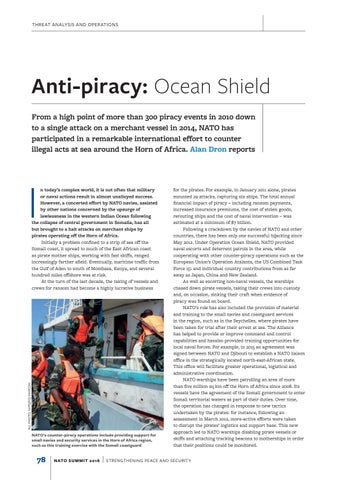THREAT ANALYSIS AND OPERATIONS
Anti-piracy: Ocean Shield From a high point of more than 300 piracy events in 2010 down to a single attack on a merchant vessel in 2014, NATO has participated in a remarkable international effort to counter illegal acts at sea around the Horn of Africa. Alan Dron reports
I
ALL PHOTO: NATO/HQ MARCOM
n today’s complex world, it is not often that military or naval actions result in almost unalloyed success. However, a concerted effort by NATO navies, assisted by other nations concerned by the upsurge of lawlessness in the western Indian Ocean following the collapse of central government in Somalia, has all but brought to a halt attacks on merchant ships by pirates operating off the Horn of Africa. Initially a problem confined to a strip of sea off the Somali coast, it spread to much of the East African coast as pirate mother ships, working with fast skiffs, ranged increasingly farther afield. Eventually, maritime traffic from the Gulf of Aden to south of Mombasa, Kenya, and several hundred miles offshore was at risk. At the turn of the last decade, the taking of vessels and crews for ransom had become a highly lucrative business
NATO’s counter-piracy operations include providing support for small navies and security services in the Horn of Africa region, such as this training exercise with the Somali coastguard
78
NATO SUMMIT 2016
for the pirates. For example, in January 2011 alone, pirates mounted 29 attacks, capturing six ships. The total annual financial impact of piracy – including ransom payments, increased insurance premiums, the cost of stolen goods, rerouting ships and the cost of naval intervention – was estimated at a minimum of $7 billion. Following a crackdown by the navies of NATO and other countries, there has been only one successful hijacking since May 2012. Under Operation Ocean Shield, NATO provided naval escorts and deterrent patrols in the area, while cooperating with other counter-piracy operations such as the European Union’s Operation Atalanta, the US Combined Task Force 151 and individual country contributions from as far away as Japan, China and New Zealand. As well as escorting non-naval vessels, the warships chased down pirate vessels, taking their crews into custody and, on occasion, sinking their craft when evidence of piracy was found on board. NATO’s role has also included the provision of materiel and training to the small navies and coastguard services in the region, such as in the Seychelles, where pirates have been taken for trial after their arrest at sea. The Alliance has helped to provide or improve command and control capabilities and hasalso provided training opportunities for local naval forces. For example, in 2015 an agreement was signed between NATO and Djibouti to establish a NATO liaison office in the strategically located north-east-African state. This office will facilitate greater operational, logistical and administrative coordination. NATO warships have been patrolling an area of more than five million sq km off the Horn of Africa since 2008. Its vessels have the agreement of the Somali government to enter Somali territorial waters as part of their duties. Over time, the operation has changed in response to new tactics undertaken by the pirates: for instance, following an assessment in March 2012, more-active efforts were taken to disrupt the pirates’ logistics and support base. This new approach led to NATO warships disabling pirate vessels or skiffs and attaching tracking beacons to motherships in order that their positions could be monitored.
STRENGTHENING PEACE AND SECURIT Y
